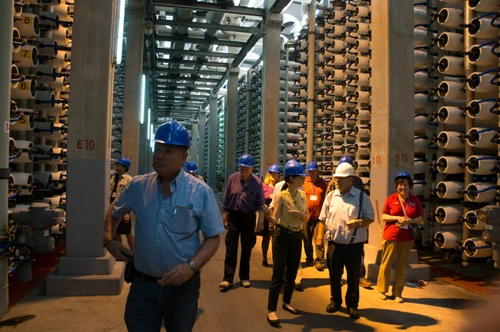Public Policy Review

As regular readers of this column know, I’ve been speaking to the benefits of learning first-hand about water management in other parts of the country and world. During the first half of November, I had the pleasure of exploring water management in Israel with nine others from our region. Through seven days of site visits and interaction with top water experts, we learned about the region’s successes as well as challenges. This uniquely designed Israel Water Management Program included stops at sites of historical water significance, tours of state-of-the art water treatment facilities, and stops at areas of environmental restoration and/or concern. The program was followed by participation by half of our group in the four-day biennial Drylands, Deserts and Desertification (DDD) Conference at the Sede Boqer campus of the Ben Gurion University. At the conference, three of us shared information and perspectives at a session, entitled “Water Management in Arizona and the Lower Colorado River Basin: Good Practices and Long-term Challenges”.
Both the water management program and the conference provided a rich framework for placing our local, state and regional water management into perspective. They provided evidence that many things are possible when stakeholders collaborate. They underscored the value of developing strategies and action plans for implementation, including financing plans. There were ample examples of successful approaches as well as situations where action plans are needed. I would like to touch on a few that are particularly relevant for Arizona and the Lower Colorado River Basin.
The first is wastewater treatment and reuse. Israel is known as a leader in the use of recycled water by agriculture. About 80 percent of treated wastewater is reused. This high level of reuse is critical to meeting the water needs of Israel’s agricultural sector. Not all water used by agriculture is recycled water. Depending on the crops and location, freshwater or brackish water may be used. However, not all household and industrial waste is properly collected and treated. Raw or inadequately treated sewage flows into streambeds. Progress is being made, but environmental problems associated with lack of proper collection and treatment persist. Although the transboundary political issues are quite different, a look at how the U.S. and Mexico have worked together at the border, particularly in recent years, could perhaps be instructive.
Another example is brackish water desalination. Israel’s well-known accomplishments with seawater desalination were discussed with us at the Hadera plant. There we met with Abraham Tenne of the Israel Water Authority and Boris Liberman of IDE, the private company that has built the large reverse osmosis plants currently operating in Israel. Great strides are also being made in brackish water desalination. We visited the Granot plant, which has been undergoing expansion for some time. Arizona will likely construct more brackish water desalination plants in the future. A major issue associated with inland desalination is disposal of the brine. The brine from the Granot plant is transported to the Mediterranean Sea. However, a plant located close to the conference site in the middle of the Negev desert far from the Mediterranean pumps the brine to evaporation ponds, which I saw during a field trip associated with the DDD conference. I was the only one on the tour bus super-excited to take a photo of the setting sun’s reflection in the evaporation ponds; I’ve already used the photo in multiple presentations! The Yuma Desalting Plant was predicated on discharge of the brine to what is now known as the Ciénega de Santa Clara. As additional plants are built, Arizona will have to consider its options for brine disposal, which could include evaporation ponds. Time will tell if a possible disposal alternative is well injection, the mechanism employed at the Kay Bailey Hutchinson desalination facilities in El Paso, Texas, which I visited in late September.
Common to our regions are dry or trickling streams and rivers and interest in restoration. The mighty Colorado River rarely flows to the Delta. We heard the many reasons for low flows of the Jordan River below the Sea of Galilee and the concomitant reduced flows into the Dead Sea. Gidon Bromberg, Israel Director of the NGO Friends of the Earth Middle East, told us about collaborative efforts to improve the Jordan River. FOEME has operations in Israel, Jordan and the Palestinian Territories. Those who saw the documentary movie Last Call at the Oasis will recall seeing the three regional directors standing together discussing the Jordan River.
From representatives of the Dead Sea Works, a privately held company, we learned about some of the many complex implications associated with potash processing operations. We also heard about proposals involving desalinating water from the Red Sea, which are the subject of a World Bank study. At the Israel Water Authority we were briefed on Israel’s Master Plan and we visited with the consultants working on the wastewater master plan. Here the difference between Israel’s centralized approach to water planning, management and pricing and our region’s decentralized approach are apparent. There, all municipal customers on the national system pay the same price for water. In our region, water prices for municipal customers vary significantly by water system.
We saw and learned so much more than I can touch on in the limited space of this column. We saw natural beauty as well as polluted streams. We saw water features of historical significance, as well as examples of deployment of state-of-the-art technology. Historically and currently, water in desert and semi-arid regions is precious. As populations grow, the challenges associated with providing safe and reliable water supplies grow. Resolving the many challenges will require creativity, tenacity and partnerships. I think we all came away from the program with renewed resolve to work collaboratively to identify and implement solutions appropriate for our region.
Note: Our independent program benefited from the participation of a professional tour guide and a liaison from the Jewish National Fund. JNF provided extensive in-kind assistance in planning the itinerary and throughout the visit.

